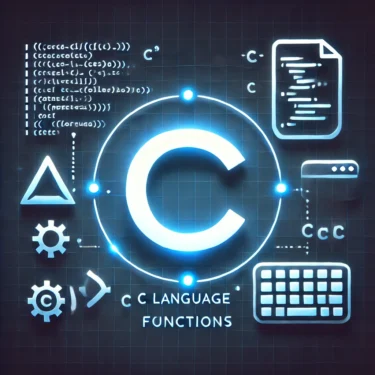目次
1. C 語言中的函式是什麼?它們的基本角色
在 C 程式設計中,函式是一段用來執行特定任務的程式碼。函式對於組織程式碼、避免重複以及改善程式結構都相當重要。妥善使用函式可以提升程式碼的可重用性,並有助於減少錯誤。本文將把常用的 C 函式分類,說明它們的用途與使用方式。
2. 標準 C 函式庫是什麼?概觀與實務應用
標準 C 函式庫概觀
標準 C 函式庫是一組內建函式,協助程式設計師有效執行各種操作。字串處理、輸入/輸出、記憶體管理、數學計算等常見任務,幾乎都由標準函式庫提供。使用這些函式可以節省時間、避免重造輪子,並確保程式碼的可靠性。
如何使用標準函式庫
要使用標準函式庫中的函式,必須包含相對應的標頭檔。標頭檔內含函式的宣告與原型。只要在程式的最前面 #include這些標頭檔,就能自由使用裡面的函式。
#include <stdio.h>
#include <stdlib.h>
#include <string.h>
3. 依類別列出的函式清單
字串操作函式
C 提供許多標準函式庫中的字串處理函式,以下列出常用的幾個:
strcpy將來源字串複製到指定的目標緩衝區。#include <stdio.h> #include <string.h> int main() { char source[] = "Hello, World!"; char destination[50]; strcpy(destination, source); printf("Copied string: %sn", destination); return 0; }
strcat將兩個字串串接起來。#include <stdio.h> #include <string.h> int main() { char str1[50] = "Hello"; char str2[] = ", World!"; strcat(str1, str2); printf("Concatenated string: %sn", str1); return 0; }
strlen回傳字串的長度。#include <stdio.h> #include <string.h> int main() { char str[] = "Hello, World!"; size_t length = strlen(str); printf("String length: %zun", length); return 0; }
輸入/輸出函式
C 為標準輸入與輸出操作提供了種函式。
printf#include <stdio.h> int main() { printf("Hello, World!n"); return 0; }
scanf#include <stdio.h> int main() { int number; printf("Enter a number: "); scanf("%d", &number); printf("You entered: %dn", number); return 0; }
fgets#include <stdio.h> int main() { char buffer[100]; printf("Enter a string: "); fgets(buffer, sizeof(buffer), stdin); printf("You entered: %sn", buffer); return 0; }
記憶體管理函式
C 使用以下函式進行動態記憶體配置:
malloc#include <stdio.h> #include <stdlib.h> int main() { int *ptr = malloc(5 * sizeof(int)); if (ptr == NULL) { printf("Failed to allocate memory.n"); return 1; } printf("Memory successfully allocated.n"); free(ptr); return 0; }
free#include <stdlib.h> int main() { int *ptr = malloc(sizeof(int)); free(ptr); return 0; }
4. C 初學者必備函式
對於剛開始學習 C 的新手,最重要、最需要先掌握的函式多與標準輸入/輸出以及基本字串處理有關。
printf/scanffgetsstrcpy/strlenmalloc/free
5. 小結
C 語言的函式是撰寫高效程式的強大工具。了解每個函式的角色以及正確的使用方式,是成功程式設計的關鍵。




